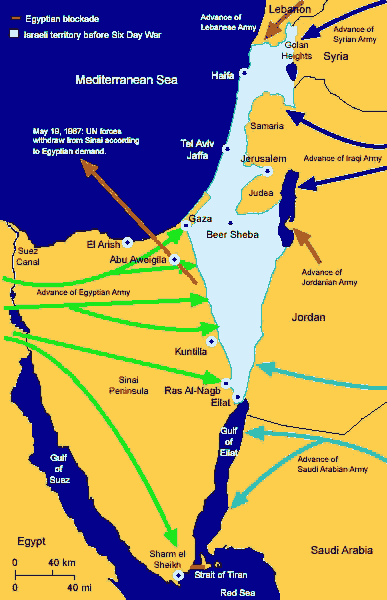The Golan Heights is rightfully Israel’s, Trump acknowledges

In June 1967, the combined armies of Syria, Egypt and Jordan (and with arms supplied by the Soviet Union) attacked Israel with the clear purpose expressed by Egypt’s President: “Destruction of Israel.” At the end of what is now known as the Six-Day War, Israel, against all odds and seemingly by divine intervention, was victorious and in possession of the territories of the West Bank, Sinai and the Golan Heights.
That control of the Golan and West Bank still resonates around the world with those that still hope to see the destruction of Israel. But so too is the growing acceptance that Israel has a right to keep the Golan from one of its arch-enemies – an enemy that still wants its destruction.
Amid recent calls for such a move, U.S. President Donald Trump stated his support on Thursday for Israel to remain in control over the strategic Golan Heights region.
The area in northern Israel was once Syrian territory and served as a strategic overlook onto the Sea of Galilee and surrounding countryside. Syrian army positions regularly fired mortars upon Israeli schools, farms, fishing boats and communities from the high vantage point. (When Metro Voice publishers Dwight and Anita Widaman, along with their family, visited the area in 2015, they explored a Syrian bunker and the strategic importance was undeniable.)
Then came the 1967 Six-Day War in which the Jewish state was attacked by Syria, Egypt and Jordan. In a stunning defeat of the region’s most powerful armies, Israel successfully defended its territory and captured the Golan Heights from the attacking Syrian army.
In 1981, Israel’s Knesset voted to apply Israeli law to the Golan Heights, but stopped short of formally annexing it. After 1967 and for the next 40 years, multiple attempts by a number of Israeli prime ministers to give the Golan Heights to Syria in exchange for peace ended in failure over Syrian refusal to cut ties with terror organizations and Iran.
The war is also how Israel came to once more control its ancient lands of Samaria and Judea–or what Western and Arab nations refer to as the “West Bank.” After Jordan launched an attack against Israel from the the West Bank, the area came under Israeli control with Jordan’s quick defeat. Israel also reunited Jerusalem which had been split in two by the Arabs into Jerusalem and “East” Jerusalem during Israel’s War of Independence in 1948.
That’s the history. The facts.
Trump’s recognition underscores what everyone knows but is afraid to say. After having been invaded several times by Syria through the Golan, the area is central to the safety of modern Israel.
“After 52 years it is time for the United States to fully recognize Israel’s Sovereignty over the Golan Heights, which is of critical strategic and security importance to the State of Israel and Regional Stability!”
Adding to what has been deemed by many as a pro-Israel agenda by the Trump administration that also included recognizing Jerusalem as Israel’s capital and moving the U.S. embassy there, Thursday’s announcement comes as Israeli Prime Minister Benjamin Netanyahu faces a close re-election battle on April 9. The move by Trump will likely been seen as a boost to Netanyahu that could be further bolstered by a visit next week to Washington, where he is scheduled to meet with Trump at the White House and address the annual AIPAC Policy Conference.
Over the phone, Netanyahu told Trump, “You made history,” according to the prime minister’s office.
Israeli Ambassador to the United Nations Danny Danon also thanked Trump.
“We are at the beginning of a historic moment for the State of Israel. President Trump once again proves the strength of the alliance between the U.S. and Israel,” said Danon. “The time has come for the world to recognize that the Golan Heights is an inseparable part of the State of Israel.”
Today, the Golan Heights remains a critically important region for Israel’s security amid the Syrian civil war. Iran, which has deepened its presence in Syria during the war, and its terror proxies such as Hezbollah poses a serious threat to Israel from Syria.
Several U.S. lawmakers on both sides of the aisle have been calling for the Trump administration to recognize Israeli sovereignty in the Golan Heights.
“There is no construct I can imagine now or any time in the future for the State of Israel to give the Golan up,” Sen. Lindsay Graham (R-S.C.) said during a recent visit to the region.
Companion resolutions calling on the United States to follow through with this recognition were introduced last month by Cruz, in addition to Sen. Tom Cotton (R-Ark.) and Rep. Mike Gallagher (R-Wisc.).
A strategic interest for Israel
Trump’s announcement was met with widespread praise by the pro-Israel community and supporters.
“Given current political and security circumstances in Syria, we have said it was inconceivable to imagine Israeli withdrawal from the Golan Heights. @realDonaldTrump’s statement marks a dramatic change in American policy, and we appreciate his leadership on this issue,” tweeted AIPAC.
“I applaud @realDonaldTrump for taking the long overdue step of recognizing Israel’s sovereignty over the Golan Heights. It’s an enormously important signal that we stand with our allies and against our enemies, and will be heard by both,” tweeted Sen. Ted Cruz (R-Texas).
Rep. Lee Zeldin (R-N.Y.) applauded the announcement as part of a larger agenda by the Trump administration.
“Yes. 100% right & a position I’ve long held as well after visiting the Golan Heights. Add this to the Embassy move to Jerusalem, signing the Taylor Force Act into law, fighting against anti-Israel & anti-Semitic hate at the UN & elsewhere, & withdrawing from the flawed Iran deal!,” he tweeted.
–Metro Voice and wire services








